
Copones is a large Maya Q’eqchi’ territory in Guatemala, in the northern province of Quiché along the Mexican border with Chiapas. Q’eqchi’ communities have lived in Copones for millennia, caring for rivers and the land generation after generation. Their territory extends over 20,000 hectares of clean rivers and fertile land.
Copones perspires autonomy. The 10,000 inhabitants are organized in 36 communities led by Ancestral Councils. Community life happens in the native Q’eqchi’ language, with only a few young people who practice Spanish when they travel outside the community. Until recently, Copones was accessible only by boat; now a dirt road has made most villages accessible in a couple of hours by truck or motorbike.
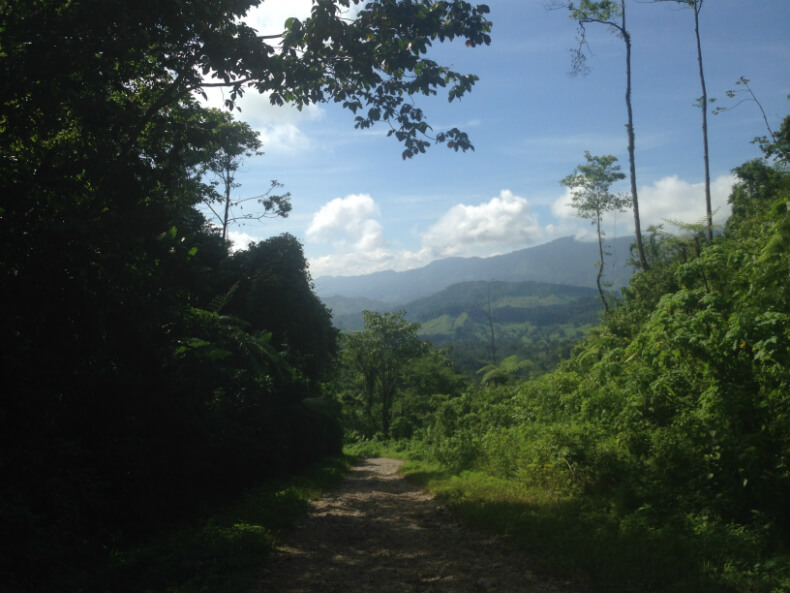
From Ixcán, it takes about two hours to reach the communal assembly house of Copones. This picture shows the communal building nested among trees and mountains, all Copones territory. Photo: Manuela Picq
Yet the Q’eqchi’ of Copones have no legal titles to their land.
The titles were issued by the state of Guatemala in 1905 and granted to militias. The Q’eqchi’ of Copones always occupied the land but were not consulted or informed that titles had been created and used as currency to pay off state debts.
The story of Copones is one more chapter in the massive grab of Indigenous lands across the New World under the terra nullius doctrine. The state of Guatemala appropriated Q’eqchi’ lands after the Liberal Revolution of the 1870s. It granted land titles as ‘rewards’ to militias demanding their dues. It declared Maya lands ‘unproductive’ and therefore ‘vacant,’ renamed the region ‘Copon de Bolas’ (aka Copones), and invented paper titles to appropriate land.
Q’eqchi’ territories were then distributed as booty of war.

Copones, as far as the eye can see. Photo: Manuela Picq
The Q’eqchi’ of Copones only realized what was happening when militias showed up claiming land. They did not settle, but they used the state-made paper titles to force many Q’eqchi’ into paying ‘rent’ for remaining on their own land in the early twentieth-century.
In 2015, the inheritors of the militias showed up again. They did not intend to settle either. They were interested in Copones rivers for hydroprojects. This time, Ixcán communities took the defense of their territories to court. Judges refused to acknowledge Indigenous rights to collective land in the case; and the Q’eqchi’ asked for the support of the Association of Maya Lawyers.
The litigation reached Guatemala’s highest court in May 2016. Ixcán’s Great Council of Ancestors are suing the state: They want the paper titles granted to militias canceled and new titles to collective territory issued for Q’eqchi’ communities.

Communities in legal consultation with Maya Layer Ixquik Poz (August 2016). Photo: Manuela Picq
The case of Copones is a legal battle between owners in practice and owners on paper.
On May 25, 2016, a hearing at the Constitutional Court became emblematic of how Indigenous communities are challenging the terra nullius doctrine in an already legendary tour-de-force of de-colonial litigation.
“We will not buy what is ours”
About 220 Q’eqchi’ authorities traveled from Copones to attend the hearing in Guatemala City. They walked into the courtroom with solemnity, carrying wood staffs (bastón de mando) as symbols of political authority, women colorfully dressed in their typical woven skirts, men wearing white Panama hats.

About 220 Q’eqchi’ authorities from Copones attended the hearing at the Constitutional Court of Guatemala in May 2016; they held their “bastones de mando” as symbols of authority and responsibility. Photo: José Agry Sian
The Q’eqchi’ of Copones had gathered an impressive legal team. Victoriano Chocooj, from the Great Council of Ancestors, represented nearly ten thousand people. Juan Castro, from the Association of Maya Lawyers, litigated with the support of three colleagues: Claudia Chopen, Edgar de Leon, and Ixquil Poz. Carlos Perez Guartambel, Kichwa-Kañari lawyer and serving President of the Confederation of Kichwa Nationalities of Ecuador (ECUARUNARI), served as Amicus Curiae. Diego Cotiy Mas testified in the name of the Great National Council of Ancestral Authorities of Mayas, Garifunas, and Xincas de Ixim Ulew Nations, created in 2009.
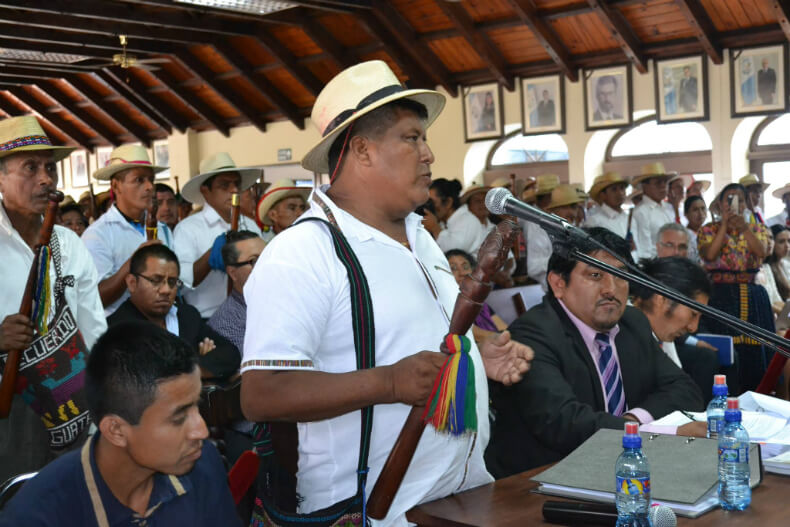
Victoriano Chocooj, from the Great Council of Ancestors, represented nearly ten thousand people. When he spoke, all the Q’eqchi’ Authorities stood up in respect and support. Photo: José Agry Sian
Chocooj opened the floor in his native language; his translator followed. As he spoke, all Q’eqchi’ authorities in the room stood up, and one could feel the five judges in their black robes somewhat intimidated in their seats. Chocooj told how they had traveled two days by bus to defend the lands their grandparents and the grandparents of their grandparents have protected for millennia. He explained that a century ago the government took advantage of their lack of knowledge of the Spanish language and legal system to appropriate lands that belong to them. He ended with a clear statement: “We will not buy what is ours.”

The judges of the state legal system listened to the case for returning land titles to the Q’eqchi’ of Copones. Photo: José Agry Sian
Retelling history: the Liberal Reform as land grab
Juan Castro followed, framing the 1870 land titles as an illegitimate act of state violence. He presented research showing that these lands have long been inhabited: Dominican priests in the 1600s were already reporting communities occupying and farming the area. There is legal evidence that Copones was never “vacant” as the government claims and that communities have been farming the land for over 250 years.
He showed a map of the Chinique municipality, to which Copones is officially attached but which is extremely distant from and much smaller than Copones. “How could the municipality of Chinique own a land so far away and so much larger than its own territory, honorable judges? It does not. This is Maya Q’eqchi’ territory.”
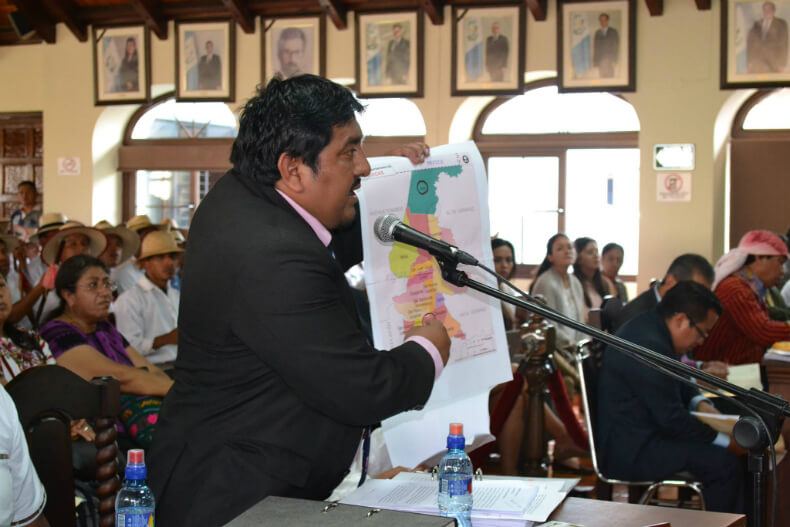
Juan Castro shows a map of the autonomous territory of Copones with surrounding municipalities to put in evidence the physical and political distance that separates Copones from Chinique. Photo: José Agry Sian
Castro retold history to explain the Liberal Reform as a vast land-grab orchestrated by the state. First, the colonial government authorized the appropriation of lands deemed empty or useless. After independence in 1847, the state of Guatemala declared vast Indigenous territories as empty/useless/unproductive lands and seized them. These were no small lands — about 20,000 hectares in the case of Copones – and they were distant enough so that land deals were negotiated on a map in some office in the capital without ever seeing its rivers. They used the municipality of Chinique to register the Copones land titles: They appropriated Indigenous lands, forging titles to pay off ex-militias asking for compensation.
Castro shot four key arguments sharper then arrows to push the judges to return the titles to their real owners.
First, he said, it is absurd to think that Guatemala’s courts are not obliged to judge this case. As a reminder, the ILO Convention 169 and the Inter-American Court of Human Rights are two legal mechanisms that explicitly guarantee collective rights to land.

Copones communities still travel a lot by river. Many people await the boat to cross the river and return home at the end of the day. Photo: Manuela Picq
Second, the 36 communities of Copones have never lost the possession and use of their land; they have always been there, continuously farming it. Chinique’s municipality cannot invoke the militias as a third party of “good faith” because lands were stolen, not bought, then given away in a violent, illegitimate land-grab.
Third, it is also absurd to argue that the case cannot be judged under current laws. Castro reminded judges of the principle of the unity of the state. All laws are inter-related. Indigenous collective land rights are inalienable, indivisible and imprescriptible. Indigenous nations have been defending their territories for over a century and courts cannot simply say they don’t have the authority to address their claims.

Corn is one of the main crops planted across Copones land. Photo: Manuela Picq
Last, when a court suggests that Indigenous communities buy the lands that were given to mercenaries, the court is telling them to buy what is theirs. This not only reproduces colonial laws, it tells millennial societies to renounce their territories, nationhood, and self-government – rights that are now guaranteed in the UN Declaration on the Rights of Indigenous Peoples.
“How dare a court tell people to buy what belongs to them?” demanded Castro.
Indigenous Territoriality
The Amicus Curiae, Carlos Perez Guartambel (ECUARUNARI), urged the court not to redirect Maya communities to legislative bodies. “Guatemala’s democratic government has failed to pay its historical debt to Indigenous peoples. This is the opportunity to do it.”
He insisted that the 1985 constitution came to correct historical wrongs, and thus prevailed over prior racist laws. “Every act of dispossession is violent,” he claimed, “and so were the 1870 titles.”
Coming from the Andes, Perez praised the wealth of Maya cultures — languages, criteria, ideas, arts, textiles. He celebrated diversity, lamenting the 1824 laws that forbade people to speak Maya languages and imposed Spanish (a rule implemented by priests in exchange for parishes). “Today, we are in court to redress past wrongs, to validate the diversity that unites us.”
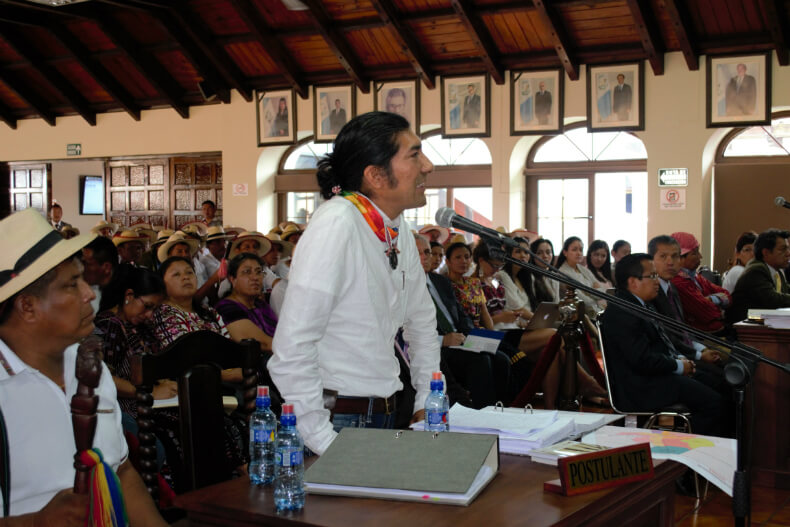
Carlos Perez Guartambel, Kichwa Kañari lawyer from the Andes, addresses the court as amicus curiae. Photo: José Agry Sian
He focused on Indigenous notions of territoriality, which go against that of terra nullius. Indigenous rights to territory are imprescriptible and inalienable. Their lands are inalienable, not resources for sale. “There is transmission, but no selling.” He cited Article 28 of UNDRIP guaranteeing Indigenous rights to reparation.
Perez posited notions of terra nullius as scientifically unsubstantiated and judicially illegitimate.
“We are 5 percent of the global population, we have only 20 percent of the land, but we protect 80 percent of the biodiversity.” Indigenous peoples are not here to claim land as a material good, but to demand justice and the respect of a reciprocal relation with the Earth as mother, he said. “We come with hope and with the promise of living together on Mother Earth.”
Diego Cotiy Mas articulated the precedence of the public good over private interests. “A governmental agreement does not have the character of law.” His position insisted on the prevalence of Maya societies over the state of Guatemala: “It’s been 502 years of colonization, but Indigenous peoples have been around for much longer. Their legitimacy as peoples is supreme, there is nothing to litigate. Juan Castro gave you all the judicial arguments to give a positive resolution to return land titles.”
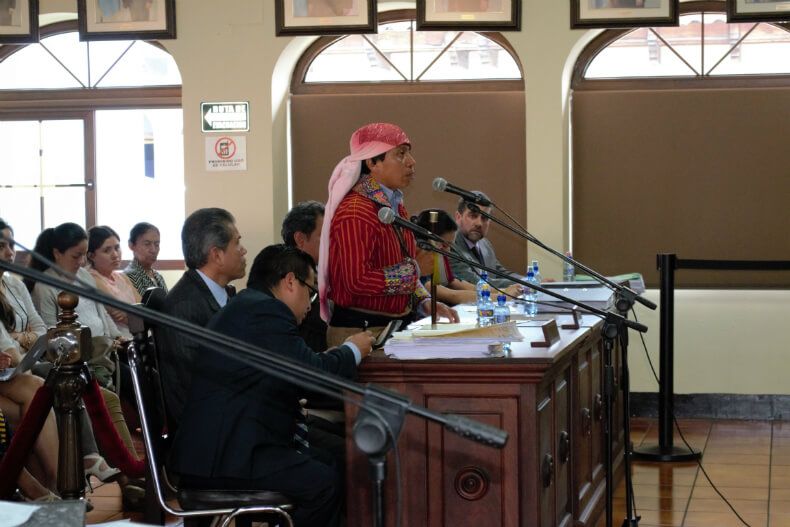
Diego Cotiy Mas represented the Great National Council of Ancestral Authorities of Mayas, Garifunas, and Xincas de Ixim Ulew Nations. Photo: José Agry Sian
Edgar de Léon analyzed how the terra nullius doctrine was designed to erase Maya sovereignty from the political map. Indigenous peoples were made invisible and historically excluded from state and constitutional treaties – notably the governmental agreements that resulted in land titles granted to militiamen. Today’s democratic government still carries a legal debt with Indigenous peoples who appear in only five constitutional articles.
Claudia Chopen noted legal precedents at the IACHR establishing indigenous rights to communal land. She claimed that one of the definitions of Indigenous peoples is the continuity on the land, its pre-existence to colonial invasion: if they are Maya communities, they likely preceded state titles. She recalled UNDRIP’s Article 26(1): “Indigenous peoples have the right to the lands, territories and resources which they have traditionally owned, occupied or otherwise used.”
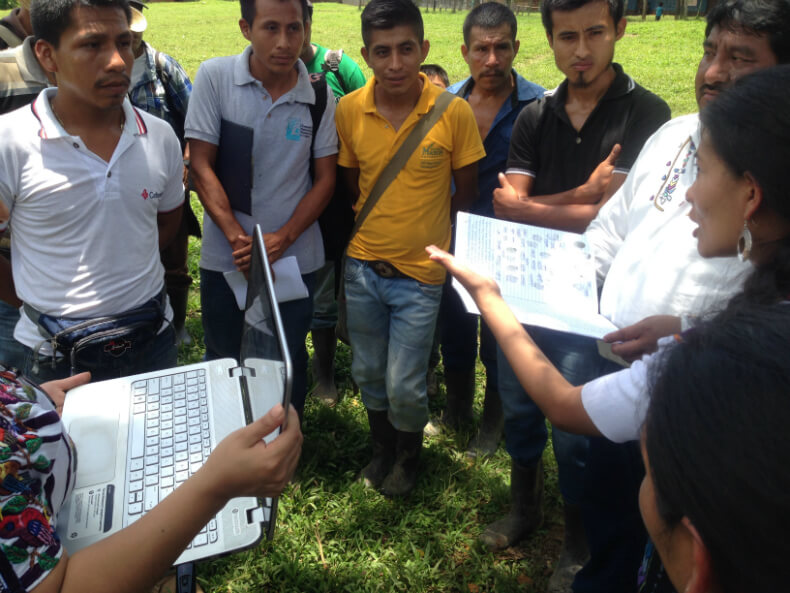
Lawyers in Copones. Photo: Manuela Picq
“The 32 Q’eqchi’ communities have evidently pre-existed colonial governments; they already existed in the popol wuj; they occupied this land before invasion and through colonial times. It is not debatable whether it is an ancestral territory.”
When the turn came of defense lawyers to intervene on behalf of Chinique’s land registry the arguments were exposed within a few minutes. They claimed that the land titles were a “technical decision” to “obey a presidential decree.” They said they understood Maya concerns but that there were no constitutional rights regulating rights to ancestral lands, and that as a result the claim should be addressed to legislators and not to the Constitutional Court.
With the ancestors
The litigation was a tour de force. The room exulted excitement by the time the five judges closed the hearing. There will be no immediate resolution. In fact, it may take years to resolve the Copones titles. But it was a historic display of Indigenous litigation.
Months later, when Maya Lawyers attended a general assembly in Copones, there were pictures of that day hanging on the walls. People remembered the hearing with pride and excitement.
How can the Ixcán communities not own the land their ancestors have cared for, for over millennia? Can they claim land without owning a title? The Q’eqchi’ authorities put it simply: “We were always there, beyond judicial evidence or booties of war that dispossess.”

Dozens of staff lay on the table showing that many ancestral authorities are attending the general assembly in Copones. Photo: Manuela Picq
This litigation matters beyond Copones. It is about ownership in practice versus ownership in paper. It confronts the legal notion of terra nullius with de facto Indigenous occupancy and emerging international rights to territory.
It is a case that brings the terra nullius doctrine back to the forefront and forces state courts to take a stand on their own colonial practices.

Indigenous Peoples are putting their bodies on the line and it's our responsibility to make sure you know why. That takes time, expertise and resources - and we're up against a constant tide of misinformation and distorted coverage. By supporting IC you're empowering the kind of journalism we need, at the moment we need it most.